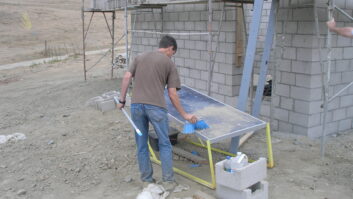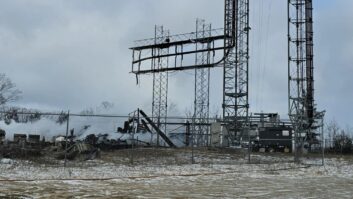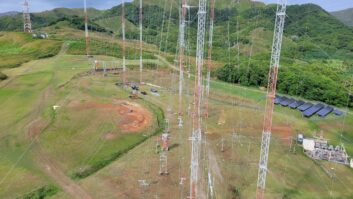When I walk through the doors at the Las Vegas Convention Center, inevitably, I make a beeline for the transmitter manufacturers� booths. Most of my colleagues do the same thing.
Aside from consoles and routing systems, nothing represents a larger commitment on your part than the purchase of a new transmitter, and therefore, they deserve a particularly high level of study. It�s easy to look primarily at the most well-known companies and then move on to the next item on your list; but there are other manufacturers out there worthy of your attention. In this article we�re going to look at many of them. I�m also including the booth numbers of the companies exhibiting at the NAB Show, which should make your floor planning a little easier.
The Armstrong X-1000B�fitting in seven rack units. Quite a few manufacturers offer AM transmitters and Armstrong Transmitter is one of them. Their X-500B and X-1000B models are rated for 600 W and 1200 W, respectively (output via rear panel PL-259 connector), and use up 7 RU of rack space (20-inches deep).

Using a PDM modulation scheme, the units are capable of 150-percent positive modulation peaks (remember � the legal limit is 125 percent). They perform at 80 percent overall efficiency (AC to RF out). Remote control GPIO remote control is accomplished via a rear-apron dB25 connector.
Armstrong also offers FM transmitters; the T series, which is a single-tube, grounded-grid design, comes in power levels up to 35 kW. Their line of solid-state transmitters includes the FM-2500B, the FM series B (up to 12.5 kW) and the series C (up to 6.5 kW).
Bext XL-2000Bext (N5434) is probably best known for their XL-series line of solid-state FM transmitters. The XL-2000 can generate (as you would expect) 2000 W but uses only two rack spaces. Power is adjustable from 0 to full power, with soft-start control; APC maintains the output power at any preset level. (Type 7-16 female DIN output connector is its standard; 7/8-inch EIA flange connector is an option.)

The XL series features a �modular layout with plug-in, easily replaceable circuits and parts,� according to their literature, and also includes a low pass/harmonic filter that meets or exceeds all FCC and CCIR requirements. Access to settings and all readings is available on the front panel via menu display, but full remote control is also provided by way of IP. Options include AES input and internal stereo generator with a fast audio clipper.
Bext recently announced a 6000 W version of the XL series. As the name implies, it can generate up to 6000 W of RF, using four RUs.
BE STX 10 The STX 10 is Broadcast Electronics� newest solid-state FM transmitter, requiring 22 RU of vertical space in a standard rack (30-inches deep). It can be seen at booth N3030. STX 10 makes use of hot-pluggable power amplifier modules and power supply modules, and achieves 70 percent AC-to-RF efficiency. (If you are planning to transmit HD Radio, you would then equip the STX 10 with a STXe 500 exciter.)

The STX 10 can be accessed from any PC, tablet or smartphone and is also SNMP V2 and V3 compatible. In fact, BE announced the release of a direct connection interface with the Davicom remote controls, making use of the built-in SNMP agent in the STX 10, and the SNMP manager in Davicom�s DV-mini and the DV-208/216 remote controls. STX 10 can also be used in an N+1 system, or in a single frequency network, due to a delay feature in the exciter.
BE offers transmitters in five power ranges. The largest single-tube transmitter line is the T-series with a range of 20 and 40 kW; the S-series offers a completely solid-state solution in the 4 to 20 kW range; the solid-state C-series range is from 500 W to 5 kW; the STX-LP series range from 1 to 5 kW; and the STXe from 5 W up to 500 W.
BE produces two lines of AM transmitters: The A series (500 W to 10 kW) and the E series, at 2.5 or 5 kW.
BW Broadcast TX2500 V2BW Broadcast (N2838) has a growing line of transmitters.

Let�s take a look at the TX2500 V2. As the name suggests, it tops out at 2500 W, but perhaps more importantly, it�s an all-in-one solution, meaning that it offers an exciter and power amplifier in one box, taking up three RU; the output connector is a 7/16-inch DIN. Additionally, the TX2500 V2 includes audio processing from BW, as well as its own stereo generator (although, since it has a composite input, you can use any processor/stereo generator combo to drive it).
It has one �slide-in� power supply module and is spec�d to run between 220 and 240 VAC. AC to RF efficiency is listed at 75 percent at the 2500W output level. The user-interface consists of 3 buttons, a rotary encoder, and a 256 by 64 graphics display.
Provisions for remote control include GPIO via rear-panel dB9 connector; remote control by way of rs-232; and remote control via IP (HTTP or telnet).
Continental�s 816R series comes in red livery.Continental Electronics (N3430) continues to offer the 816R line of FM transmitters and the 816-HD and 816-HDR lines (HDR meaning �HD-ready�). The 816R line covers the power range of 11 to 40 kW, using the same three-bay design for the last 30 years, with the 4CX15000A, the 4CX20000E or the 4CX25000C (depending upon power level, of course) driven by the solid-state IPA.

The 816HD family of transmitters is based on three different analog FM and HD power levels: the 816HD-20 for power up to 20 kW; the 816HD-25 up to 25 kW of power; and the liquid-cooled 816HD-28L for applications up to 30 kW of analog power.
Common features of the Continental line of FM transmitters are the single-tube design; solid-state IPA; SCR �soft-start;� automatic power output control; use of the quarter-wave cavity in the output amplifier; use of the grounded screen grid circuit using screen neutralization; automatic filament voltage regulation; automatic power interrupt recycle; two independent VSWR protection circuits; and a positive-pressure cabinet, which helps to keep the inside of the transmitter clean.
The Crown E-250 allows for monitoring in the cloud. If you are in the market for a lower power transmitter, then by all means visit Crown Broadcast at N3831.

The Crown E-250 (from Ecreso � see below) supports both analog and AES inputs (sample rates up to 192 kbps) with built-in silence detection and automatic fail-over driving the built-in stereo generator. The E-250 also has a composite input so that you can make use any combination audio processor/stereo generator.
The E-250 also includes an integral RDS encoder and an FSK IDer (should you want to use it as a translator).
Crown has a line of stand-alone FM transmitters, as well, including the FM600. It�s available in three configurations: The E is a basic exciter with composite input only; the T could be a good choice for the lower-power broadcaster because it includes a built-in audio processor and stereo generator; and the R is the translator option with built-in receiver.
Crown also offers a line of FM of higher power transmitters, including the FM1K, FM2K, FM4L and the FM10K.
Ecreso FM 10 kWEcreso (part of WorldCast Systems, N6134) has an extensive line of solid-state FM transmitters, from power levels as low as 100 W, to as high as 10 kW. Some of the common features in this product line are direct-to-channel digital modulation; built-in stereo generator; analog and digital audio inputs; silence detection and intelligent failover; GPIOs for local remote control; an embedded Web browser and SNMP for remote control; and a dynamic RDS encoder.

Perhaps more interesting are the ways in which the Ecreso transmitters can be operated via IP; they could be particularly useful for those of you with a far-flung network of transmitters.
Advanced Measurement Interface allows the end user to see a real time dashboard that provides an at-a-glance overview of the transmitter performance. Built-in instrumentation enables detailed analysis of the RF spectrum, baseband spectrum, audio spectrum and peak meters, all displayed simultaneously.
Expert Maintenance Reporting is a proactive service which sends regular reports on the status of parameters, such as temperatures, currents and voltages, plus information on the performance and lifespan of components such as the fan and power supply of the transmitter. The system works through a data cloud managed by WorldCast Systems.
Once access to the service is granted, the user can enable the EMR service on Ecreso transmitters within seconds with an authorized account ID. From then on, the transmitters will automatically push reports to the EMR Cloud for centralization, in-depth processing and automatic notification.
Elenos ETG Indium lineElenos (N1530) is offering a compact line of FM transmitters they�ve christened the Indium series, comprising the ETG 2500, the ETG 3500 and the ETG 5000, fitting in four RU of rack space and using a 7/8-inch EIA flange on the output. Included is a built-in exciter, with a composite input, meaning that any audio processor/stereo generator combination can be used; additionally, the ETG series includes a built-in stereo generator with analog and AES inputs (24-bit, 32 through 96 kbps sample rate, with automatic fail-over the analog).

More than 50 parameters are available on the front panel OLED display; configuration and adjustments can be done via the front panel as well. RS-232/485 access is available via the front panel; remote control can also be accomplished via GPIO or optionally via SNMP.
The ET Indium high power product line consists of FM transmitters in which the high power output is obtained through the combination of a suitable number of 4RU medium power amplifiers (5000W), a single ETG 2RU, or dual set of 2 ETG 2RU exciters and a combiner for the power amplifiers. The overall RF power of the models in this product line ranges from 10 kW to 60 kW.
The GatesAir FLX, liquid-cooled versionGatesAir (booth N2512) will be showing an extensive line of FM transmitters.

Let�s look at the Flexiva FLX liquid-cooled transmitter range (for power levels between 5 and 80 kW). The FLX incorporates a heat exchanger that is �more efficient than air-cooled processes, especially at higher power levels,� according to their literature. The heat-to-liquid transfer process cools the power amplifiers without dumping the excess heat in to the space surrounding the transmitter, thus lowering the air conditioning needs, further reducing utility costs.
FLX includes redundant cooling pumps operating in a closed-loop design, with auto-changeover capability. The pump and heat exchanger motors are speed-controlled to lower operating costs and provide optimum cooling performance over an array of weather conditions.
Some of the Flexiva�s other important features are as follows:
? For air-cooled versions: continuously variable speed fans optimize cooling; redundant internal cooling fans draw air from front to rear with ducted air options available
? Digital Ready: FM, FM and HD Radio, HD Radio-only
? Maintains power up to 1.5:1 VSWR. Proportional VSWR fold-back for safe operation at reduced power into marginal loads (icy antenna etc.)
? Global control and monitoring via IP; the remote graphical user interface works with any PC, tablet or smartphone
? Full SNMP network control and monitoring support
? Diagnostics and setup via an easy-to-use front-panel control
? N+1, Dual Transmitter and Main/Alternate and with automatic switching capability
GatesAir continues to offer AM transmitters as well � the line includes the Flexiva DX (10 and 15 kW); the Flexiva 3DX (25, and 50 kW); and, the Flexiva DAX (1-6 kW).
The 40 kW model is part of the Nautel GV line. At booth N2522 you can see Nautel�s newest transmitter line for FM, the GV series. It�s completely solid-state and of modular design, so that failures in one (or more) PA modules, or power supply modules or the user interface itself, will not take the transmitter completely off-the-air.

This year Nautel will expand the GV product line to include 60 and 80 kW models. All GV Series transmitters include Nautel�s Advanced User Interface with 17-inch touch screen monitor and IP access; so whether you are on-site in front of the transmitter or at some other location, 100 percent of the AUI is available to help you manage the transmitter. With the AUI, you can configure and/or monitor the following:
? All the individual preset configuration: frequency, power level, HD power level, program audio input
? Dynamic RDS scrolling
? New oscilloscope instrumentation
? Unique MER instrumentation
? RF and audio spectrum analyzers
? Monitoring and control to the sub-module level
? Logging of all events
? SNMP support
? Email notifications
The real-time measurement of modulation error ratio provides the ability to diagnose issues such as interference with the MP3 carriers near the analog signal due to FM analog signal over-modulation.
Nautel offers line of AM transmitters as well, known as the NX series, at the 5, 10, 25 and 50 kW levels. This year at the show they�re introducing 3 and 15 kW versions to the NX series.
Modules are �hot-pluggable� for OMB EM 5000 HE. At the N4332 booth you will find the transmitter manufacture OMB. They offer a line of solid-state FM transmitters from the 500 W up to the 5000 W level. Their EM 5000 HE �hot plug� is comprised of three of their FMA 2000 HE power amplifiers, achieving greater than 73 percent AC to RF efficiency. As the name implies, the RF amplifier modules are �hot-pluggable� as are the power supply modules.

Some of its other features are the TFT screen and touch keyboard to control and to visualize operational parameters; speed control of cooling fans according to temperature of power modules to optimize power consumption while minimizing dust accumulation and noise; advanced protection against load mismatches and fast protection in case of excessive reflected power and/or excessive input power; and, remote control by GPIO, RS-232, or optionally, IP (both HTTP and SNMP).
This is a power amplifier only and would require an exciter, such as OMB�s EM 25 DIG Plus, for the complete system. The DIG Plus supports analog mono, composite, and (optionally) AES inputs. A built-in stereo generator is an option as well.
The Gamma comes in five power levels between 2 and 5 kW. The PTEK (N4130) Gamma series of FM transmitters (between 2 and 5 kW) have the following common features: built-in exciter and stereo generator with analog inputs (with external composite input as well); FSK IDer (for use in translator service); frequency agility; AC power input accepts 208-264 V range; and front panel metering, with a local remote control interface. Four RUs needed up to the 3.5 kW range; seven RU for the 4 and 5 kW versions.

PTEK offers the ES Series of transmitters as well, with output powers from 300 W to 1200 W.
The Rohde & Schwarz TH9 family can be used for FM, HD Radio or DAB.Rohde & Schwarz (SL1205) is a transmitter manufacturer that many of you are probably not familiar with � though it�s one of the largest internationally. Their THR9 high-power FM transmitter line is liquid-cooled and can deliver FM output of up to 40 kW in one rack and 80 kW in two racks.

The THR9 transmitter family for band II attains overall efficiency values of up to 75 percent in analog FM mode; they incorporate redundant transmitter cooling systems; and they support the hybrid HD Radio standard (IBOC) as well as purely digital standards in band II (87.5 to 108.0 MHz).
I�m trying to decide which is more fun: Sitting down to dinner with business associates and friends that I see once per year � or standing at a transmitter company�s booth, grilling sales guys with questions. At this year�s NAB Show, I plan to consider that question once again.












